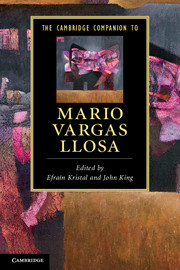Book contents
- Frontmatter
- Introduction
- 1 Reality and rebellion: An overview of Mario Vargas Llosa’s literary themes
- 2 The early novels: The Time of the Hero and The Green House
- 3 The total novel and the novella: Conversation in The Cathedral and The Cubs
- 4 Humour and irony: Captain Pantoja and the Special Service and Aunt Julia and the Scriptwriter
- 5 The historical novel: The War of the End of the World
- 6 Innocence and corruption: Who Killed Palomino Molero? and The Storyteller
- 7 The political novels: The Real Life of Alejandro Mayta and Death in the Andes
- 8 The erotic novels: In Praise of the Stepmother and The Notebooks of Don Rigoberto
- 9 The dictator novel: The Feast of the Goat
- 10 From utopia to reconciliation: The Way to Paradise, The Bad Girl and The Dream of the Celt
- 11 The essays
- 12 The memoir: A Fish in the Water
- 13 The plays
- 14 Film and the novels
- 15 An interview
- Further reading
- General index
- Index of selected fictional characters
- Index of selected works by Vargas Llosa
3 - The total novel and the novella: Conversation in The Cathedral and The Cubs
Published online by Cambridge University Press: 28 January 2012
- Frontmatter
- Introduction
- 1 Reality and rebellion: An overview of Mario Vargas Llosa’s literary themes
- 2 The early novels: The Time of the Hero and The Green House
- 3 The total novel and the novella: Conversation in The Cathedral and The Cubs
- 4 Humour and irony: Captain Pantoja and the Special Service and Aunt Julia and the Scriptwriter
- 5 The historical novel: The War of the End of the World
- 6 Innocence and corruption: Who Killed Palomino Molero? and The Storyteller
- 7 The political novels: The Real Life of Alejandro Mayta and Death in the Andes
- 8 The erotic novels: In Praise of the Stepmother and The Notebooks of Don Rigoberto
- 9 The dictator novel: The Feast of the Goat
- 10 From utopia to reconciliation: The Way to Paradise, The Bad Girl and The Dream of the Celt
- 11 The essays
- 12 The memoir: A Fish in the Water
- 13 The plays
- 14 Film and the novels
- 15 An interview
- Further reading
- General index
- Index of selected fictional characters
- Index of selected works by Vargas Llosa
Summary
Conversation in The Cathedral (Conversación en La Catedral, 1969) is arguably the greatest novel about Peru, and a compelling literary statement about corruption in Latin America. It is also unsurpassed as a work of narrative fiction in its ability to explore how individuals, communities and even an entire social world can be undermined by the corrosive effects of corruption. As David Gallagher pointed out in a seminal essay published in 1973, Conversation is the culmination of Vargas Llosa's literary explorations of Peru of the 1960s, in as much as ‘it finds its way to the proper formal structure and the proper language’ to offer a damning picture of a nation in which every individual is compromised or corrupted in one way or another. Gallagher calls it a literary investigation of a nation's ‘original sin’, summed up in a question, in its opening paragraph, the most quoted line from any Peruvian novel: ‘¿En qué momento se había jodido el Perú?’ (politely: At what point was Peru ruined?)
The question is asked, in an interior monologue, by Santiago Zavala, the novel's protagonist, and Vargas Llosa's most complex and best-developed character. Santiago wonders when his own life was ruined as he ponders on the misery and degradation of Peru. In this novel, the ruin of a nation and the ruin of myriad individual destinies are one and the same. Conversation in The Cathedral is a series of concentric stories that encompass the experience of a nation whose epicentre is the story of Santiago.
- Type
- Chapter
- Information
- The Cambridge Companion to Mario Vargas Llosa , pp. 37 - 48Publisher: Cambridge University PressPrint publication year: 2011

